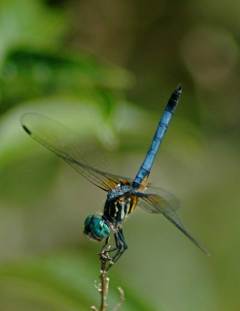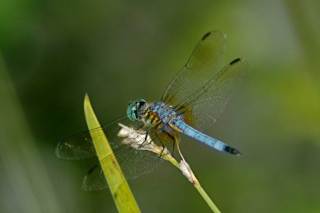It was a lot of fun sitting out back proofreading this morning. The humidity is down, so the temperature, while “the same” according to the thermometer as it was before T.S. Nicole/T.D. 16 blew through, is a lot more livable. (It’s starting to feel like fall; the typical way it arrives here in south Florida: an inch at a time, with lots of backsliding and sweating a la summer.)
I’m not sure whether it’s connected to the nicer weather, but we had what I would almost call an infestation of dragonflies today: mostly Blue Dashers, but a few larger skimmer species as well. They were dripping from every available perch in the backyard: shrubs, trees, telephone wires. They were in the oak trees in the front yard, on the streetlight (boo! hiss! light pollution!) wires. It was astonishing!
Here are a couple of photos (male Blue Dashers, Pachydiplax longipennis) that turned out nicely:
If you want to see what a real swarm of dragonflies looks like, or find out more about how and why they swarm, see this post on the dragonfly woman’s website. All I know is today it was a lot of fun to be a backyard naturalist!
[UPDATE: I’d been meaning to look up the origin of this species’ name, which I keep misremembering as Brachydiplax. Turns out that pachy, which we all recognize from pachyderm, is Greek for thick. Plax, placos, is Greek for plate, tablet: anything wide and flat. Longipennis is Latin for long-winged (yes, 2 n’s, people). So this species’ name translates to “thick double-plated long wings.” I’m not really sure if Burmeister, who named it in 1839, had that exact meaning in mind, but, since I haven’t been able to get to a source telling me otherwise, this is what it means to me. If anyone out there has a better translation for me, I’d love to hear it.
If you go to Needham and Westfall (1955; thanks, M!) or Needham, Westfall, and May (2000; I wish!), you can find this: “the genus is easily recognized by a single venational character: the single crossvein under the distal end of the [ptero]stigma has a vacant space, about as long as four normal cells, between it and the four postnodal crossveins of the second row. … Length of wings not remarkable, though the specific Latin name makes reference to it. Shortness of abdomen in female gives impression of long wings.”
So the generic name might refer to that long empty spot under the pterostigma; I’m not sure if that’s what Burmeister had in mind, but it’s my working hypothesis.]
[Update, February 2012: Thanks to the North American Odonata checklist of Dunkle and Paulson, I can now update the etymology of the generic and specific names: Pachydiplax means “thick Diplax,” referring to the “stout female abdomen in comparison with members of the old libellulid genus Diplax”; “longipennis” does indeed mean long-winged, but D&P specify that it is in relation to the relatively short female abdomen.” It’s so nice to have an authoritative starting point for etymological information about these creatures!]


